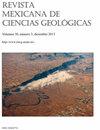从大地电磁和环境噪声数据看科利马火山的岩浆系统
IF 0.5
4区 地球科学
Q4 GEOSCIENCES, MULTIDISCIPLINARY
Revista Mexicana De Ciencias Geologicas
Pub Date : 2023-04-01
DOI:10.22201/cgeo.20072902e.2023.1.1707
引用次数: 0
摘要
在这里,我们展示了在1000–0.05 Hz的频率范围内对21次大地电磁测深的全阻抗进行三维反演的结果。结果证实,在科利马火山(CV)下2-4 km bmsl深处存在一个扁平的导体,作为科利马-火山复合体热液系统的天然盖层。从三维反向阻抗中提取的五个EW垂直剖面的模型结果表明,上层地壳(1000欧姆·米)比南部地区更致密,在南部地区,它变得更导电,显然更破碎。水平和垂直电阻率切片和剖面的组合结果显示,科利马火山下有一个椭圆形的垂直导体(10–20欧姆·米),从大约5公里的bmsl延伸到至少15公里的bmsr。沿断层的椭圆导管长轴和短轴的近似尺寸分别约为20km和5km。椭球增强传导路径的主轴平行于北东-西南主断层系统外的NS断层段,这表明该断层段目前正在控制岩浆流体的上升。低至约15-18km的bmsl,地壳变得广泛导电,与类似深度的科利马火山下低剪切波速(<3.2km/s)的平坦体相吻合。这种低密度、低电阻率的平坦糊状储层含有富含H2O的熔体,这些熔体易于被电极化并使周围介质极化。支持证据表明,CV最近和不久的将来的活动与深部平坦的岩浆源密切相关,而不是与浅部岩浆室密切相关,并且CV的复发性岩浆活动的触发机制可能具有电成分。本文章由计算机程序翻译,如有差异,请以英文原文为准。
The magmatic system of the Colima Volcano from magnetotelluric and ambient noise data
Here we present the results obtained from the 3D inversion of the full impedance of 21 magnetotelluric soundings in the frequency range of 1000–0.05 Hz. The results confirm the existence of a flat lying conductor at a depth of 2–4 km bmsl under the Colima Volcano (CV) acting as a natural cap seal of the Colima Volcanic Complex hydrothermal system. Model results along five EW vertical sections extracted from the 3D inverted impedance show that the upper crust (<15 km) in the northern sector of the CVC is far more resistive (>1000 ohm·m) and compact than in the southern zone, where it becomes more conductive and apparently more fragmented.
The combined results of horizontal and vertical resistivity slices and sections reveals a vertical conductor (10–20 ohm·m) of ellipsoidal shape under the Colima Volcano, which extend from about 5 km bmsl down to at least 15 km bmsl. The approximate dimensions of the major and minor axis of the elliptical conduit along the fault are about 20 km and 5 km respectively. The major axis of the ellipsoidal enhanced conducting pathway is parallel to a NS fault segment off the main NE-SW fault system, which suggests that this fault segment is currently controlling the magmatic fluids ascent.
Down to about 15-18 km bmsl the crust becomes widespread conductive, coinciding with a flat body of low shear-wave velocity (<3.2 km/s) under the Colima Volcano at similar depths. This low density and low resistivity flat lying mush reservoir contains H2O-rich melts prone to be polarized electrically and to polarize the surrounding medium. The supporting evidence suggest that the recent and near-future activity of the CV is closely related to a deep flat magmatic source rather than to a shallow magmatic chamber, and that the triggering mechanism of recurrent magmatic activity of the CV may have an electrical component.
求助全文
通过发布文献求助,成功后即可免费获取论文全文。
去求助
来源期刊

Revista Mexicana De Ciencias Geologicas
地学-地球科学综合
CiteScore
1.00
自引率
12.50%
发文量
0
审稿时长
6-12 weeks
期刊介绍:
Revista Mexicana de Ciencias Geológicas (RMCG) publishes original research papers on geological processes of broad interest, and particularly those dealing with regions of Latin America. The RMCG also publishes review papers on topics of current interest, and on the geology and tectonics of geological provinces of Latin America. Besides, it offers the opportunity for host editors to publish special thematic issues.
 求助内容:
求助内容: 应助结果提醒方式:
应助结果提醒方式:


